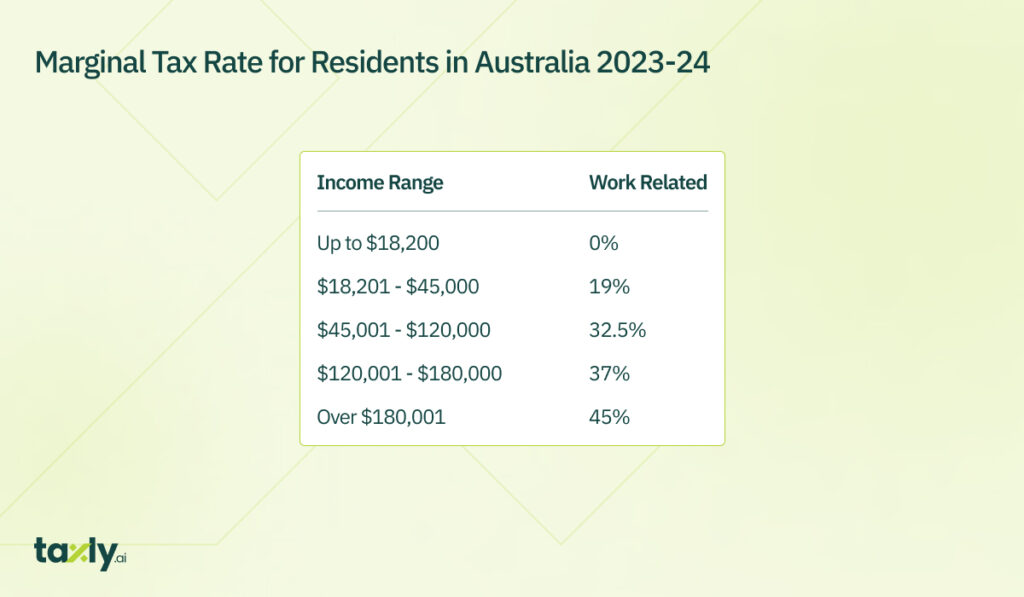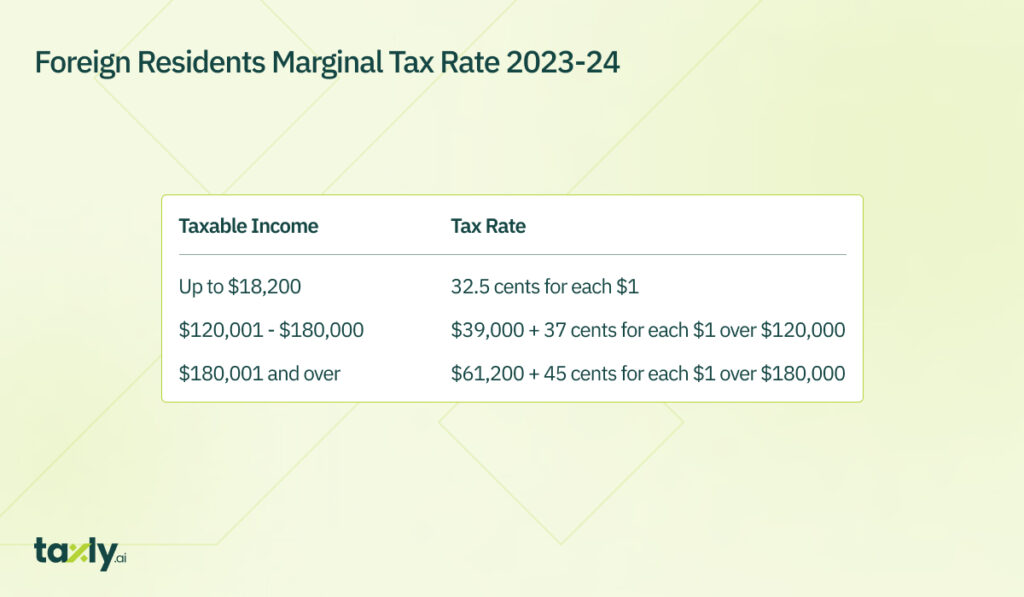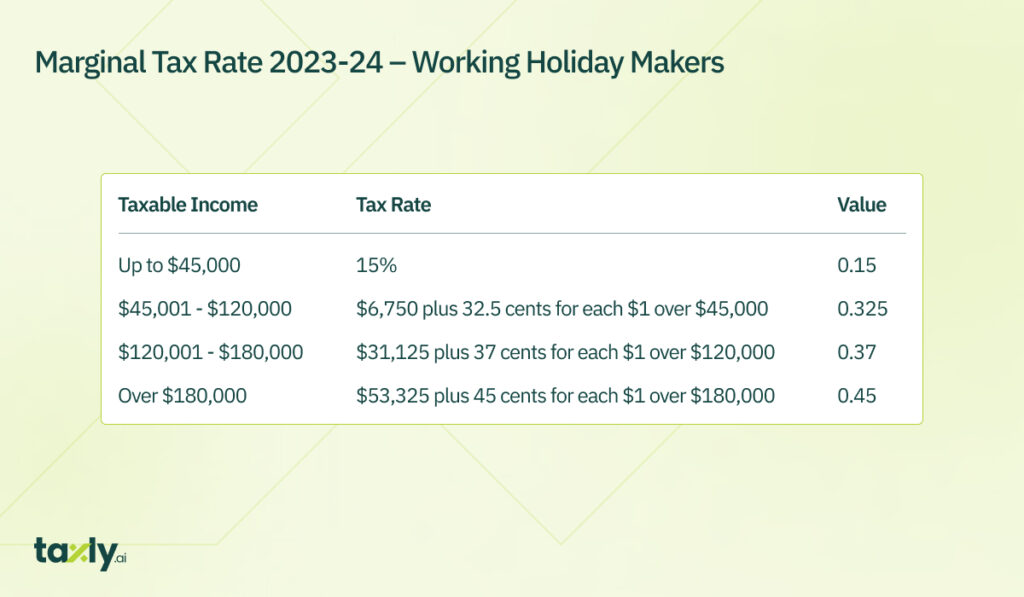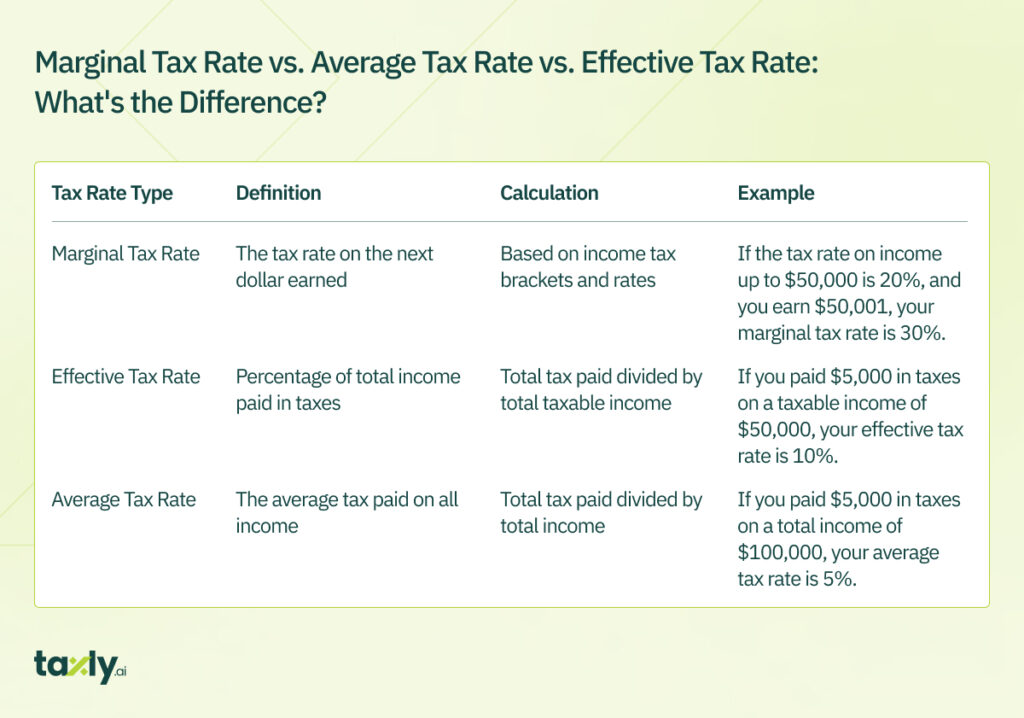Are tax rates giving you a headache? Don’t worry – we’re here to the rescue! In this blog, we’ll break down the marginal tax rate. Whether you’re a rookie or a seasoned tax pro, this marginal tax rate guide will help you understand which tax rate applies to your income bracket.
We will also cover:
- The marginal tax rate for residents, foreign residents, and holidaymakers
- Differences between marginal tax rate, effective tax, and average tax
- Factors influencing the Australian marginal tax rate
In Australia, the tax system operates on a progressive basis. It means that the more income you earn, the higher the tax rate you’ll pay on each additional dollar you make.
What is the Marginal Tax Rate for Residents in Australia?
The marginal tax rate is applicable on the next dollar you earn.
Marginal Tax rates are divided into different income brackets or tax brackets.
These rates apply to your taxable income, which is your total income minus any allowable deductions and tax offsets.
Marginal Tax Rate for Residents in Australia 2023-24

A 2% Medicare levy is also applicable for residents.
How to Calculate Marginal Tax Rate?
Let me break it down for you. Your income falls into different brackets, each with its corresponding marginal tax rate. Here’s an example of how it works:
Suppose your annual taxable income is $60,000.
- The first $18,200 is tax-free.
- The next $26,799 (i.e., $45,000 – $18,201) is taxed at 19%, which amounts to $5,092.81.
- The next $15,000 (i.e., $60,000 – $45,001) is taxed at 32.5%, which amounts to $3,875.
- So, your total tax payable for the year would be $5,092.81 + $3,875 = $8,967.81.
This is just a rough example to help you understand the concept. Your actual amount may vary depending on eligible deductions and tax offsets.
What is Marginal Tax Rate For Foreign Residents in Australia?
Marginal tax rates for foreign residents in Australia differ from those applicable to Australian residents.
If you’re a foreign resident for tax purposes, you don’t meet any of the four residency tests provided by the Australian Taxation Office (ATO).
The ATO has a handy online tool to help you determine if you fall under this category. The four tests you need to take to pass tax residency are:
Foreign Residents Marginal Tax Rate 2023-24

Foreign residents must declare any income earned in Australia, such as employment, rental, Australian pensions and annuities, and capital gains on Australian assets.
Unlike Australian residents who benefit from a tax-free threshold, foreign residents start paying tax from the first dollar they earn in Australia. The tax rates vary depending on your taxable income.
For the financial year 2023-2024, the marginal tax rates for foreign residents are as follows:
- For taxable income up to $120,000, you’ll pay 32.5 cents for each dollar earned.
- For taxable income between $120,001 and $180,000, you’ll pay $39,000 plus 37 cents for each dollar over $120,000.
- For taxable income $180,001 and over, you’ll pay $61,200 plus 45 cents for each dollar over $180,000.
A significant advantage for foreign residents is that they are not required to pay the Medicare Levy.
Remember that tax rates and regulations may change over time, so it’s always best to check with the Australian Taxation Office (ATO) for the latest information or seek advice from a tax professional.
Special rates apply for children under 18 on unearned income (like investment income).
Marginal Tax Rate 2023-24 – Working Holiday Makers
A different marginal tax rate applies to you if you’re on a 417 (Working Holiday) or 462 (Work and Holiday) subclass visa.

For the financial year 2023-24, the Australian Taxation Office (ATO) has set out these rates to determine how much tax you’ll pay on your hard-earned dollars.
Let’s break it down:
- If your taxable income is up to $45,000, you’ll pay a flat and friendly rate of 15%. Not bad, right?
- If your income falls between $45,001 and $120,000, you’ll owe $6,750, plus an extra 32.5 cents for every dollar you make over $45,000.
- If you bring in between $120,001 and $180,000, you’ll pay $31,125, plus an extra 37 cents for each dollar you earn above $120,000.
- For high-earners making over $180,000, you’ll pay $53,325 and 45 cents for every additional dollar you earn above $180,000.
Sounds like a lot, huh? But don’t worry! The tax system is here to keep things fair and help support the country’s services and infrastructure.
If You Fail To Provide TFN, You are subject to High Tax Rate
Oh, and one more thing! If you don’t provide a tax file number (TFN), your tax rate will be slightly higher – a whopping 45% on all your income instead of just the portion above $180,000. So be sure to sort out your TFN to avoid unnecessary tax surprises!
Use a Simple Tax Rate Calculator App
Tax rates are influenced by:
- Tax offsets
- Tax credits
- Higher education loan scheme repayments
- Medicare levy
To simplify things, use an AI-powered tax rate calculator app to determine your tax rate accurately.

What Factors Influence Marginal Tax Rate?
Great Question! The following factors influence the marginal tax rate in Australia:
Taxable Income:
The more money you earn, the higher your marginal tax rate. As your income increases, you move into higher tax brackets, each with its tax rate. So, the more you make, the more tax you pay on each extra dollar you earn.
Tax-Free Threshold:
As an Australian resident, you can earn up to a certain amount ($18,200 as of my last update) without paying any tax. This is known as the tax-free threshold. Any income above this threshold is taxed at the applicable rates.
Tax Offsets and Deductions:
Deductions and tax offsets can lower your taxable income, affecting your marginal tax rate. Deductions are expenses you can claim, like work-related expenses, which reduce your taxable income. Tax offsets directly reduce the tax you owe.
Residency Status:
Your tax rate can vary depending on your residency status. Australian residents, foreign residents, and temporary visa holders like working holidaymakers may have different tax rates and benefits.
Medicare Levy:
The Medicare Levy is a 2% tax to fund Australia’s healthcare system. It applies to most taxpayers, but some low-income earners may be exempt or eligible for reductions.
Government Changes:
The Australian government may change tax laws, rates, and thresholds, impacting your marginal tax rate. It’s essential to stay updated with the latest information from the Australian Taxation Office (ATO).
Marginal Tax Rate vs. Average Tax Rate Vs. Effective Tax Rate: What’s the Difference?

Average Tax Rate Takes Your Overall Income and Tax into Account
The Average Tax Rate reflects the percentage of your income you pay in taxes on average. It’s like finding the middle ground. Knowing this rate helps you understand how much of your earnings go toward taxes. You can use it for budgeting and financial planning.
Effective Tax Rate Reflects Percentage of Income Paid into Taxes
The Effective Tax Rate shows you the percentage of the total income you pay in taxes. It’s like seeing the true picture of your tax burden. This rate considers all your income and deductions, giving you a comprehensive view of how taxes impact your wallet.
Marginal Tax Rate Is Applicable on the Next Dollar You Earn
Marginal Tax Rate tells you how much you’ll pay on the next dollar earned. So, as you make more money, your Marginal Tax Rate increases.
The Difference? Tax Brackets!
Your Average Tax Rate takes into account your whole income.
On the other hand, the Marginal Tax Rate considers the next dollar you earn. They diverge when you enter a new tax bracket.
If you want to understand your overall tax situation and see the real tax you pay, the Effective Tax Rate steps in. It considers all your income and deductions, giving you the true story of your tax burden.
As you earn more and move up the income ladder, your Marginal Tax Rate may increase. However, your Average Tax Rate might not jump as high since it’s an average of your overall income and includes the lower tax rates.
How do you calculate marginal and average tax rates?
Let’s take the same example with a taxable income of $50,000.
The total tax paid is the sum paid in each bracket:
- For the first $18,200, the tax paid is 0%.
- For the next $26,800 (i.e., $45,000 – $18,200), the tax paid is 19%.
- For the remaining $4,800 (i.e., $50,000 – $45,000), the tax paid is 32.5%.
Total tax paid = 0% + (19% of $26,800) + (32.5% of $4,800) = $5,092
Average tax rate = Total tax paid / Total taxable income = $5,092 / $50,000 ≈ 10.18%
So, the average tax rate for a taxable income of $50,000 is approximately 10.18%.
Deductions and Credits
Deductions and credits lower your Average Tax Rate, but your Marginal Tax Rate remains unchanged as it applies to the next dollar earned. Tax credits reduce your tax bill dollar-for-dollar, impacting your Average Tax Rate.
Here is the Bottomline:
- The average Tax Rate gives you the overall picture of what you pay on average in taxes
- Effective Tax Rate shows you the percentage of income you pay into taxes
- The marginal Tax Rate is applicable on your next dollar earned
AU Tax Policy Changes and How They Affect Your Tax Situation
The Marginal Tax Rates Shuffle
Alright, let’s get down to it. Tax policy changes play a real-life game with our pockets, and one key player in this game is the “marginal tax rate.”
It’s the tax you pay on each extra dollar you earn. So, when the government tweaks tax laws, these rates can go up or down and impact how much you owe.
For example, if the government decides to lower the tax rates for your income bracket, you’ll take a sign of relief as you get to keep more of your hard-earned cash.
But hold on! If tax rates go up, you might feel like you’re giving away too much of your paycheck. Ouch!
The Income Groups Scoreboard: Who Wins, Who Loses
It’s not just you – tax policy changes hit us all differently! Different income groups experience unique impacts based on their earnings.
For lower-income groups, tax cuts or targeted credits are a sweet deal. More money in your pocket means easing the pressure on day-to-day expenses. It’s like finding extra coins in your couch cushions!
On the other side of the field, higher-income earners feel the weight of tax rate increases for their bracket. Adjusting your financial game plan might be necessary to handle the larger tax burden.
Staying Ahead of the Tax Game: Preparing for What’s Next
Tax policy isn’t set in stone – it keeps changing. So, it’s savvy to stay informed and ready for future twists in tax rates.
Keeping an eye on upcoming changes helps you plan your financial moves smartly. Plus, you can score big points by knowing about deductions and credits you might be eligible for.
Teaming up with a registered tax pro can give you the winning edge! They’ll guide you in minimising your tax load and optimising your financial strategy.
Wrapping it Up
Don’t sweat the tax rates – we’ve got your back! Understanding the marginal tax rate and its differences from other tax rate types is key to financial success. Your Marginal Tax Rate focuses on that next dollar earned, while the Effective Tax Rate shows your overall tax picture. By understanding your applicable marginal tax rate, you can make savvy money moves and tackle taxes like a pro!
Marginal Tax Rate – Frequently Asked Questions
What is the maximum marginal rate of income tax?
The maximum marginal income tax rate is the highest tax rate for the highest income bracket. For example, if the highest income bracket is taxed at 45%, that’s the maximum marginal rate.
What is marginal income?
Marginal income refers to the additional income you earn beyond your current level. For example, if you earn $50 more, your marginal income would be $50.
What is the highest marginal tax rate in Australia?
Australia’s highest marginal tax rate is 45%. It applies to taxable income above $180,000.
What is the lowest marginal tax rate?
The lowest marginal tax rate in Australia is 0%. It applies to income up to the tax-free threshold of $18,200.
Related Links:



Comments are closed